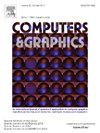社会人群模拟:通过社会规则和凝视行为改善现实性
IF 2.8
4区 计算机科学
Q2 COMPUTER SCIENCE, SOFTWARE ENGINEERING
引用次数: 0
摘要
当前的人群仿真模型主要关注的是转向一个目标,同时根据智能体的运动方向避免碰撞。这导致了类似机器人的模拟,因为代理似乎总是将他们的注意力与运动方向完美地结合在一起。在现实世界中,我们观察到人类在人群中移动,通过注意、凝视和非语言协调来避免碰撞。此外,人类表现出不同的转向策略是基于他们是独自行走还是成群行走,他们是否能向前看并计划他们最好的局部运动,或者因为他们的目光从他们的运动方向转移而做出更突然的反应。人类的凝视可以由运动驱动,也可以由与他人交谈或使用手机等分心因素驱动。这些人类特征在人群模拟中被忽略了,常常导致个体在局部的完美平滑运动。不幸的是,当观察2D显示的结果时,这种缺乏社交行为和多样性的动画可能会被认为是不现实的,而在参与者与虚拟人处于视线水平的沉浸式场景中,这种情况可能会变得更加明显。本文提出了一种新的方法,通过将社会规则和注视驱动的注意力与一致的动画相结合,来增强基于规则的人群模拟模型的真实感。最终目标是使沉浸式虚拟人群更加逼真。我们提出的方法通过整合影响个体和集体动态的社会行为模型来增强现有的人群模拟框架,并驱动凝视行为以更好地模拟注意力。我们对2D显示器和沉浸式VR进行了验证用户研究,并观察到将这些模型应用于转向和动画水平可显着提高人群模拟的真实感。基于视频比较的基于2D显示的用户研究表明,与仅使用运动或随机动画的传统避碰方法相比,我们的模型被认为更真实,更符合社会行为。沉浸式用户研究表明,参与者有效地检测到我们的模型中包含的社会行为。结果显示,在我们的社会群体模型中,参与者对各种行为的感知存在显著差异。本文章由计算机程序翻译,如有差异,请以英文原文为准。

Social crowd simulation: Improving realism with social rules and gaze behavior
Current crowd simulation models focus mostly on steering towards a goal while avoiding collisions based on the agent’s direction of movement. This leads to robot-like simulations since agents’ appear to always have their attention perfectly aligned with the direction of movement. In the real world, we observe that humans move in a crowd performing collision avoidance driven by attention, gaze, and non-verbal coordination with incoming traffic. In addition, humans exhibit different steering strategies based on whether they walk alone or in a group, whether they can look ahead and plan their best local movement, or react more abruptly because their gaze diverts from their direction of movement. Human gaze can be driven by movement, but also by distractions such as being engaged in conversation with other people or using mobile phones. These human features are overlooked in crowd simulation, often leading to perfectly smooth local movements of individuals. Unfortunately, this lack of social behavior and variety in animations may be perceived as unrealistic when observing the results on a 2D display, and it may become even more apparent in immersive scenarios where the participant is at eye level with the virtual humans. This paper proposes a novel approach to enhance the realism of a rule-based crowd simulation model by incorporating social rules and gaze-driven attention with consistent animations. The ultimate goal is to make immersive virtual crowds more realistic. Our proposed method enhances existing crowd simulation frameworks by integrating social behavior models that affect both individual and collective dynamics, and drives gaze behavior to better simulate attention. We conducted validation user studies on both a 2D display and in immersive VR, and observed that applying these models to both the steering and animation levels significantly improves the realism of the crowd simulation. The 2D display based user study based on video comparisons showed that our model was perceived as more realistic and consistent with social behaviors compared to traditional collision avoidance approaches, that used only locomotion or random animations. The immersive user study showed that participants effectively detected the social behaviors included in our model as intended. The results revealed significant differences in the participants’ perceptions of the various behaviors exhibited by our social crowd model.
求助全文
通过发布文献求助,成功后即可免费获取论文全文。
去求助
来源期刊

Computers & Graphics-Uk
工程技术-计算机:软件工程
CiteScore
5.30
自引率
12.00%
发文量
173
审稿时长
38 days
期刊介绍:
Computers & Graphics is dedicated to disseminate information on research and applications of computer graphics (CG) techniques. The journal encourages articles on:
1. Research and applications of interactive computer graphics. We are particularly interested in novel interaction techniques and applications of CG to problem domains.
2. State-of-the-art papers on late-breaking, cutting-edge research on CG.
3. Information on innovative uses of graphics principles and technologies.
4. Tutorial papers on both teaching CG principles and innovative uses of CG in education.
 求助内容:
求助内容: 应助结果提醒方式:
应助结果提醒方式:


